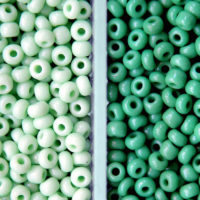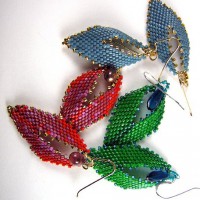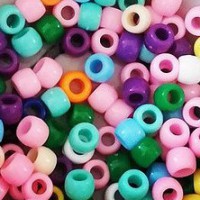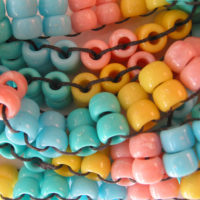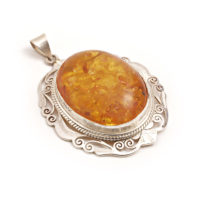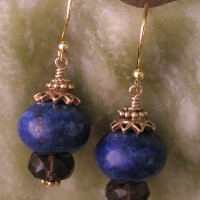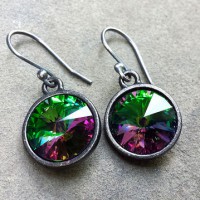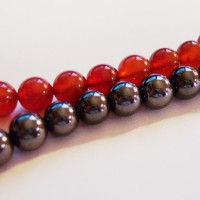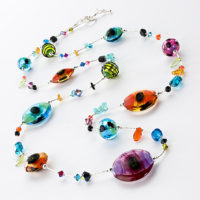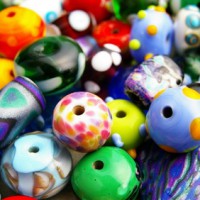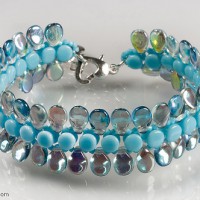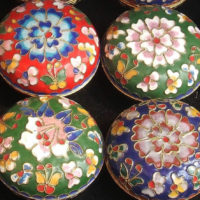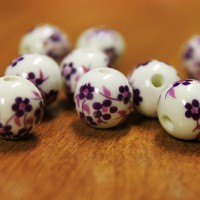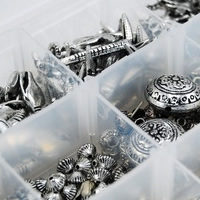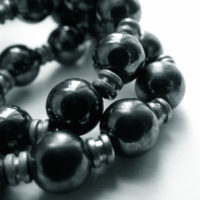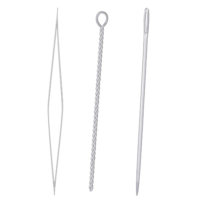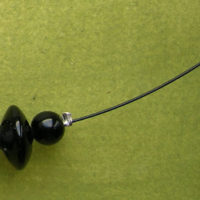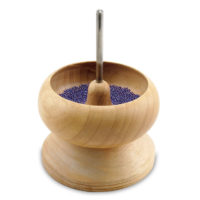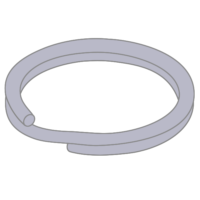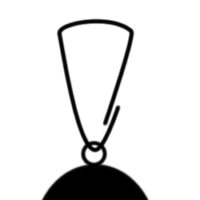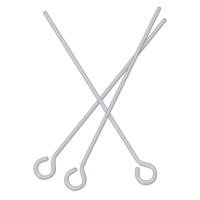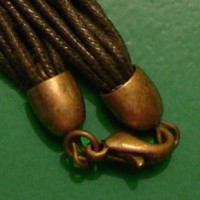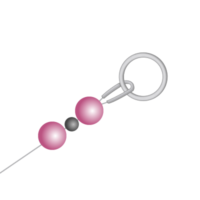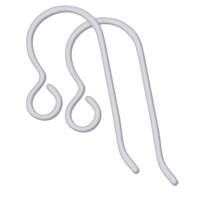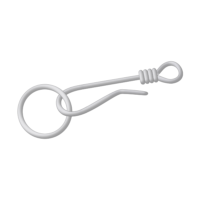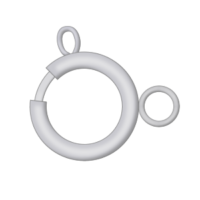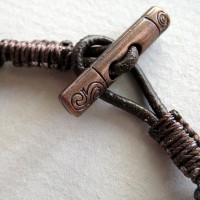Description
Beadwork is the art or craft of attaching beads to one another by stringing them with a sewing needle or beading needle and thread or thin wire, or sewing them to cloth.[1] Beads come in a variety of materials, shapes and sizes. Beads are used to create jewelry or other articles of personal adornment; they are also used in wall hangings and sculpture and many other artworks.
Beadwork techniques are broadly divided into loom and off-loom weaving, stringing, bead embroidery, bead crochet, and bead knitting.
Beads, made of durable materials, survive in the archaeological record appearing with the very advent of modern man, Homo sapiens.[2]
Beads are used for religious purposes, as good luck talismans, for barter, and as curative agents.
History .
Modern beading
Beadwork adaptation of painting by Vittore Crivelli.
Modern beadwork is often used as a creative hobby to create jewelry, handbags, coasters, plus dozens of other crafts, and even copies of paintings. Beads are available in many different designs, sizes, colors, shapes, and materials, allowing much variation among bead artisans and projects. Simple projects can be created in less than an hour by novice beaders, while complex beadwork may take weeks of meticulous work with specialized tools and equipment. Many free patterns and tutorials can be found in Internet.[3]
Ancient beading
Broad Collar, c. 1336–1327 B.C.E., c. 1327–1323 B.C.E., or c. 1323–1295 B.C.E., 40.522, Brooklyn Museum
Faience is a mixture of powdered clays and lime, soda and silica sand. This is mixed with water to make a paste and molded around a small stick or bit of straw. It is then ready to be fired into a bead. As the bead heats up, the soda, sand and lime melt into glass that incorporates and covers the clay. The result is a hard bead covered in bluish glass.
This process was probably discovered first in Mesopotamia and then imported to ancient Egypt. However, it was the Egyptians who made it their own art form. Since before the 1st dynasty of Narmer (3100 B.C.) to the last dynasty of the Ptolemaic Kingdom (33 B.C.) and to the present day, faience beads have been made in the same way.
These beads predate glass beads and were probably a forerunner of glass making. If a beadmaker was a little short of clay and had a little extra lime and the fire is hotter than usual, the mixture will become glass. In fact some early tubular faience beads are clayish at one end and pure glass at the other end. Apparently the beads weren't fired evenly.
The uneven beads were noticed early on, this led to experimentation, slowly at first. It took a long time for new ideas to be accepted in a conservative, agricultural society. One of the first variations to take hold was to color the faience beads by adding metallic salts. By the beginning of the eighteenth dynasty (1850 B.C.), faience making and glass making had become two separate crafts.
Faience beads were so common because they were cheaper and less labor-intensive to make than stone beads. Aside from personal use and daily wear they were used to create beaded netting to cover mummies. Most of the archaeological specimens come from burials.[4]
As early as the Old Kingdom (circa 2670–2195 B.C.), Egyptian artisans fashioned images of gods, kings, and mortals wearing broad collars made of molded tubular and teardrop beads. These beaded collars may have been derived from floral prototypes. In antiquity the collar was called a wesekh, literally "the broad one".[5]
In the Americas, the Cherokee used bead work to tell stories. They told them by the patterns in the beads. They used dried berries, gray Indian corn, teeth, bones, claws, or sometimes sea shells when they traded with coastal tribes
Skills Needed
Skills Developed
Time
As much as you want to invest.
Cost
Beading on a Budget
Beading as a hobby can quickly add up. Here are some strategies to save money without sacrificing quality.
1
Prepare Before Shopping
When you go to your local bead shop, go with an end in mind, and a budget for what you’re looking for. Give yourself another budget to just buy fun beads with. That way you can let yourself be “tempted”…but within limits. And just like you shouldn’t shop for food when you’re hungry, don’t shop for beads when you’re emotional, stressed, or distracted–it’s too easy to buy for the rush of excitement, rather than the cool-headed knowledge of what you’ll really use.
2
Beware Quality at Craft Stores
You can get good coupons and deals at big craft chains like Michael’s–but you may be sacrificing quality. Pay special attention to the description on the item you are buying. For example, glass beads sold at craft stores are usually not kiln-annealed, a process which prevents cracking and breaking. Metal is usually plated, and can tarnish easily. Check the package for broken or bent pieces. You can find some good stuff–just be extra careful to know what you’re buying.
3
Subscribe to Online Stores for Deals
Big online retailers like Fire Mountain Gems regularly have sales. Subscribe to their newsletter so you can catch them when they happen.
4
Design Using Cheaper Materials
When you’re working out a jewelry design, you might end up taking apart your work and starting over several times. Don’t bust out your sterling-silver wire until you are sure what you will make with it.
Equipment
Beads
Beads are the foundation of making beaded jewelry–here is an introduction to common bead types.
Gauged Beads
Gauge is a measurement of the thickness of something, be it beads, wire, thread, or needles. Gauged beads come in gauges ranging from 6/0 (large) to 15/0 (tiny).
Seed Bead Made of glass or plastic and available in an amazing array of colors, finishes, and styles. Because of their small, regular size they are used in bead weaving and loomwork to make larger patterns. 11/0 is the most common size. Delicas are cylindrical, squarish seed beads that are about size 12/0.
Delica beads A variety of seed bead that is small and perfectly cylindrical, so they easily snap into place in peyote stitch and brick stitch beadweaving. They also have large wholes for their size, making it easier to pass multiple strands of thread through each bead. Delica is actually a brand name, made by Miyuki--the generic term is "cylinder bead".
Charlotte Beads A type of seed bead where one side is cut (faceted), making them sparkle. Originally they were only made in 13/0 and therefore charlottes in other sizes are sometimes referred to as "true cuts" or "one cuts". photo credit
Bugle Beads Sized like seed beads, bugle beads are long tubes ranging in length from 2 to 35 mm.
Pony Beads Larger than most seed beads and smaller than crow beads, also available in a large range of colors and finishes. Equivalent to size 8/0 or 6/0 seed beads, also called E-beads. photo credit
Crow Beads The same shape as seed beads, but much larger than seed beads with larger holes. They are also available in a large range of colors and finishes but are most often made of acrylic rather than glass.
Bead Shapes
Briolette Teardrop or pear-shaped bead or gemstone. Can be faceted or smooth. photo credit
Cabochon Piece of semi-precious or precious stone that is cut and polished, but that contains no facets. Often large and oval.
Bicone A type of bead that looks like two pyramids or cones stuck together at their bases. photo credit
Barrel Bead Barrel refers to the shape of the bead - the bead can be made of any material such as metal, glass, wood, or plastic. photo credit
Rondelle A shape of bead that looks like a round bead slightly flattened. photo credit
Rivoli A shape of bead that consists of two short wide cones stuck together at their bases (like a flying saucer). In other words, they are round and come to a point in front and back. They do not have holes, so to incorporate one in jewelry you need to have a setting for it, like a cabochon. Usually a bezel setting is used--you can make one with seed beads using peyote stitch, or purchase metal ones. photo credit
Pillow Bead A rectangular bead with rounded edges.
Heishi Beads Heishi or heishe beads are small disc or tube shaped beads usually made of stone, shell or wood. They were first made from shell by Native Americans of the New Mexico area. Authentic heishe beads are handmade and can take days to produce strands of 2 - 3mm beads. Strips of shell or stone are drilled with evenly spaced holes, cut into squares, then shaped and smoothed by hand. The beads are beautifully smooth and uniform donut shapes.
Materials
Gemstone Precious (sapphire, ruby, diamond, emerald) and semiprecious (hematite, amethyst, jade, onyx, etc.) stones are available in chips and in different shapes.
Venetian Beads A style of glass bead making originating in Venice in the late 1800s. Antique "fancy" Venetian Beads are rare and prized by collectors. Today, many types of beads made by hand in Murano and Venice are sold under this label. Generally the term denotes a very high level of craftsmanship and that the beads are made individually by hand.
Lampwork Lampwork beads are made by melting narrow rods of glass by hand over an open flame (usually a torch). The glass is wrapped around a thin metal rod (a mandrel), which later becomes the hole through the bead. Many effects can be achieved through using various colors of glass and various techniques. Lampwork beads can also be crated into small figurines such as faces or animals.
Czech glass Glass made in the Czech Republic, where the tradition of craftsmanship in glass-making goes back centuries. Also called Bohemian glass or Bohemia crystal. photo credit
Crystal This can refer to many things, but in beading it usually means either naturally occuring quartz gemstones, or man-made leaded glass beads. Adding lead to glass beads makes them sparkle more; the more lead, the higher quality the bead. It also adds weight, so really light "crystal" beads are probably just glass. Man-made crystal beads come in a variety of sizes, shapes, and colors like cubes, rounds, rondelles, and specially shaped pendants of all kinds. There are many types of crystals available, but Swarovski crystals seem to be the most popular and are widely considered the highest quality.
Enamel A silicone-like substance that is baked on metal, glass or ceramic beads to apply decorative color, glossy finishes, or protective coating. Some enamel applications are detailed and contain many colors like a painted floral design. Enamel beads became widely popular during the 60s and throughout the 70s, but were not as common in the 80s and 90s. Today, enamel beads are available from almost any bead retailer and are extremely popular.
Polymer Clay A sculpting material which can be formed into shapes and then baked to harden. Polymer clay is available in most craft stores in a wide range of colors, and can be used to make beads and pendants.
Porcelain A ceramic material made from firing clay at very high temperatures (~1300 Celcius) so the silicate present in clay turns to glass, giving porcelain its characteristic strength and translucence. photo credit
More Bead Types
Name Beads Beads with letters on them that can be used to spell names or other words. Also called alphabet beads.
Miracle beads These unique beads have a lucite (acrylic) core which is coated with a silver mirror-plated layer and finished with several layers of colored lacquer. The result is an illusion of depth or a "bead within a bead". I'm not sure if this qualifies as a miracle, but they do look pretty cool.
Bali beads Originally, Bali beads referred to sterling silver beads made individually by hand in Bali, Indonesia. The style has since been mass produced and sold under the same moniker.
This is just a few–there are millions of beads of many different sizes, shapes, and materials, such as glass, bone, shell, clay, metal, pearls, seeds, and even paper.
Utility Beads
Spacer Beads Any small bead can be used as a spacer. Spacer beads are often unnoticable (on purpose) but serve an important function in the spacing of a jewelry design. The bead can be made of any material; it is referred to as a spacer bead based on its function in the design. Often spacer beads are small metal beads or glass seed beads.
Stop Bead A seed bead used in beadweaving to keep your first row of beads in place when you start your piece. Instead of knotting the thread, you secure the stop bead by passing thread through it several times, and then remove it later when you have completed the beadwork.
Bead Stringing Supplies
Stringing With Thread
Needles For regular stringing, twisted-wire needles work well as the large eye closes to fit through the beads. For seed beads, use beading needles. These resemble sewing needles but are usually longer and thinner. The larger the number, the thinner the needle (to match sizes of seed beads).
Thread Several fibers spun into a single strand. Beading thread is made of nylon and is used in beadweaving and loomwork. Other types of thread used in beading include decorative cords such as rattail.
Glue Bead cement or craft glue can be used to keep thread knots from unraveling or keep small pieces in place. Temporary glue can be used to hold work together while assembling it. Use craft glues, or one of the several glues specifically designed for beadwork.
Callotte Metal findings that cover the knot at the end of a string of beads. Callottes (also called clam shells) clamp sideways onto the knot. Tying the knot around a seed bead and adding a drop of glue secures the knot. Close the callotte with pliers and snip the excess thread. Also called clamshells or bead tips.
Stringing With Beading Wire
Beading Wire A thin wire or cable made from braiding several strands of thin steel wire together and then coating them with nylon. It is stiff so it does not require a needle to use. Brands of beading wire include Accu-flex, Beadalon, and Soft Flex. Beading wire is extremely strong and durable, although it is prone to kinking. Beading wire cannot be tied in a knot like thread, so jewelry must be finished using crimp beads.
Crimping Pliers Specialized pliers for squishing crimp beads. Recommended for those who plan to use crimp beads often.
Crimp Beads Crimp beads are small metal beads that you squish (crimp) onto beading wire to make the beads stay where you want them, or connect beading wire to a jump ring or clasp. They can be corrugated or smooth.
Other Stringing Materials
Cord Cord is thicker than thread and usually a woven product. Many materials are used to make cord for beading, such as satin, leather, suede, hemp, flax, silk, and nylon.
Monofilament Clear plastic thread used for fishing line. It is almost transparent and requires no needle, but is easily stretched and cut, so you may not wish to use it for finished jewelry if durability is a concern. It is useful for trying out designs. It's also great for the invisible floating necklace look. Buy Illusion Cord
Tools
Bead Spinner A bowl with a central spindle that makes it easier and faster to string strands of seed beads or liquid silver. A curved beading needle is placed in the beads in the bowl and threads them as you spin the bowl.
Jewelry Findings
Findings are small components used to make a collection of beads into jewelry. Usually these are metal, but they can also be made of wood, stone, or other materials.
Connectors
Jump Ring Used to connect jewelry parts, like attaching a clasp to a necklace. Jump rings are a simple wire loop. To open them, push one end forward and one end back. If you enlarge the circle by prying the ends farther apart you will weaken the metal. Split rings are more secure but bulkier.
Split Ring Double wire rings (like a keychain), used to connect different parts of a piece of jewelry. A split ring is more secure than a jump ring but also bulkier.
Bail A finding that connects a pendant to a necklace. They come in different forms: some clip onto the pendant, some have mounts to glue the pendant to, and some attach to a ring on the pendant. The purpose is to hold the pendant flat when worn.
Headpins Headpins look like small thin nails. Put a few beads on a head pin, bend a loop in the top, and you have a dangle which can be made into an earring with the simple addition of an earwire.
Eyepins Eyepins are just like a headpins except instead of a head there is a loop. You can make these yourself out of wire - just cut a length and make a loop in one end. But if you want them super-straight you'll have to buy them.
Crimp Beads Crimp beads are small metal beads that you squish (crimp) onto beading wire to make the beads stay where you want them, or connect beading wire to a jump ring or clasp. They can be corrugated or smooth.
Finishers
Callotte Metal findings that cover the knot at the end of a string of beads. Callottes (also called clam shells) clamp sideways onto the knot. Tying the knot around a seed bead and adding a drop of glue secures the knot. Close the callotte with pliers and snip the excess thread. Also called clamshells or bead tips.
Beading cone A metal cone finding that covers the ends of the strands in a multi-stranded necklace. The cone lets you attach a clasp, while concealing the knots that secure the ends of the strands.
Bullion Also known as French Wire or Gimp. This is a very finely coiled wire that forms a flexible tube like a spring. It is used for finishing the ends of strung jewelry pieces. It is threaded over the cord to cover it where it is normally exposed, such as where the cord goes through the loop on the clasp at the ends of the piece. It gives a professional look and protects the bead cord from fraying from exposure. The downside is that it tends to wear rather quickly itself, so it is good for fancy jewelry that you don't wear often.
Earwire The most common commercial earwire has a coil, a metal ball, and a loop that can be opened to attach to an earring. Earwires are available in different compositions and finishes, like gold filled, silver plated, brass, or steel. Choose a color that complements your earring design.
Clasps
Lobster Claw Clasp A secure clasp useful for finishing necklaces, bracelets, and other jewelry.
Barrel Clasp A common form of clasp, especially for necklaces. Can be hard to attach on bracelets without help, and often comes undone on anklets, so is best suited for necklaces.
Hook and Loop Clasp A type of clasp that is very easy to use. It can be made by hand with some wire (gauge 20 or thicker), however it may come apart if the hook is stretched. Hammering the wire with a ball pein hammer and anvil can harden it so this is not an issue.
Fish Hook Clasp The fish hook clasp refers to the extra safety mechanism. When the clasp is opened, a hook wraps around a safety bar. This added security feature is in place in case that the clasp should accidentally open up, and works quite well to secure the necklace when it's being worn.
Spring Ring A very common clasp which is inexpensive and secure. The drawback is that it requires nimble fingers to use.
Toggle Clasp A type of clasp consisting of a bar which fits into a loop. It operates on the same principle as a button. Toggle clasps tend to be bulky and therefore most appropriate for chunkier jewelry. This clasp is also sometimes used as a main decorative element in a necklace that clasps in the front. photo credit
Beaded https://beadage.net/
Members Only Area
Here is where you find more resources. Including schools, instructors, tour and guide operators. many within your local areas.
You will also find
Resources
Associations & Organizations
Blogs
Bead Bee Beading Blog - project ideas, how to make jewelry . . . beads.beadbee.com
Beading blogs, books and magazines are a great way to get ideas and teach you to visualize how beads will look together as you are designing.
Inspirational Beading
inspirationalbeading.blogspot.com
Greetings, beaders! I have been putting off a return to the blog for quite some time, ... Support Inspirational Beading for bonus tutorials and more!
Books
Forums
Magazines
Videos
Websites



